Newsletter
Current
Previous
|
September 2008
|
|
Earley
Environmental
Group |
|
Newsletter September 2008
Issue 13
www.earleyenvironmentalgroup.co.uk |
Earley Old English 'Earnley -eagle wood' |
|
 isappointing to read from a recent wildlife magazine poll of 700 children that, for many, playing in the countryside was their least popular way of spending their spare time, and that they would rather see friends or play on their computer than go for a walk or play outdoors (see p.7). Perhaps, as well as technological temptations, another obstacle is that there are not the opportunities to play in the wild, as fondly remembered by older family members. With land at such a premium, wild or waste bits are almost non-existent in Earley. Sir David Attenborough is alarmed that young people with little experience of the natural environment will not grow into caring adults. On the positive side, those youngsters who took part in our bug hunt in Maiden Erlegh Reserve seemed to thoroughly enjoy exploring for minibeasts. The ‘hands-on’ approach appeals to young children, as you can see from the report of the bug hunt on p.5 but perhaps a more ‘crusading’ role suits older children. Schools can and do play a big part in encouraging this interest in the wild environment, with opportunities for children to explore even a small part of their school habitats and, in secondary schools, a wider look at problems facing the planet (see ‘What price an orang-utan?’ p.7). isappointing to read from a recent wildlife magazine poll of 700 children that, for many, playing in the countryside was their least popular way of spending their spare time, and that they would rather see friends or play on their computer than go for a walk or play outdoors (see p.7). Perhaps, as well as technological temptations, another obstacle is that there are not the opportunities to play in the wild, as fondly remembered by older family members. With land at such a premium, wild or waste bits are almost non-existent in Earley. Sir David Attenborough is alarmed that young people with little experience of the natural environment will not grow into caring adults. On the positive side, those youngsters who took part in our bug hunt in Maiden Erlegh Reserve seemed to thoroughly enjoy exploring for minibeasts. The ‘hands-on’ approach appeals to young children, as you can see from the report of the bug hunt on p.5 but perhaps a more ‘crusading’ role suits older children. Schools can and do play a big part in encouraging this interest in the wild environment, with opportunities for children to explore even a small part of their school habitats and, in secondary schools, a wider look at problems facing the planet (see ‘What price an orang-utan?’ p.7).
We haven’t forgotten our own local wildlife, with a chance to build a hedgehog box in September, and a look in October at the changing scenarios in our gardens as some birds leave for different climes and others arrive to enjoy the English autumn and winter. Young or old, we can all play a part in conserving our environment: Peter Baveystock of Wokingham Borough Council will brief the group about recycling and its problems in November, and the article by Edwin on p.3 suggests measures to prevent flooding (see p.8 for venues and dates of talks).
|

September Birds
Paving our way to a flood-free future
Green Heroes
A Trip Down Memory Lane
Local News – Green Fair, Bug Hunt, Butterfly Garden, Tree Statistics
A Look at Old Earley
News from Earley and Beyond
Forthcoming events, etc.
|
Get to know your Earley or just beyond
History on our doorstep
‘NO, NO, I never walk’, once said Oscar Wilde, one of the most renowned people to be associated with Reading, through his imprisonment in cell no. C 3.3. Reading Gaol from November 1895 to May 1897 on a charge of homosexuality, then a crime. In happier days he had joined house-parties in Reading by well-known families like the Palmers, and even toured the biscuit factory. He had earlier professed a ‘detestation’ for nature but seemed to change his mind when in prison, and talked of the healing power of, ‘the beauty of the sun and moon, the pageant of the seasons, the music of daybreak and the silence of great nights, the rain falling through the leaves, or the dew creeping over the grass and making it silver...’. He left Reading Gaol a broken man, bankrupt, having lost all his valued personal possessions, only living two more years in France, where he wrote his famous poem, The Ballad of Reading Gaol, under the pseudonym ‘C 3.3’. (continued on page 4) |
|
September is a good time to go looking for birds, since it is a busy season: the population has swollen after the breeding season, and there is an enormous amount of movement going on. There is still plenty of insect life, plenty of seed in the hedgerows and fields, plenty of fruit in the bushes and trees. A walk round Dinton Pastures at this time can easily produce upwards of fifty species, even for a fairly casual observer.
However, with many adults now in less striking plumage than earlier in the year, and youngsters looking different from their parents, it can be difficult to be sure of the identity of each one. Post-breeding moult renews worn and soiled feathers, and by September there are a lot of birds in new suits, though many of the returning ducks will be very tricky to identify, since normally showy males will still be in their drab “eclipse” phase. With so much variety, this is the time for a good, modern handbook which shows a variety of plumage types for each species.
What makes the season really exciting is that it is a time of movement. Though it is not always obvious to us, even some of our familiar birds, like robins, thrushes and blackbirds will move south and will be replaced by birds from places like Scandinavia. Some birds which have been with us just for the summer, such as swallows, martins and warblers, will now be moving south too, though the swifts left last month. More northerly populations of such birds will continue to move through for some weeks, and well into October.
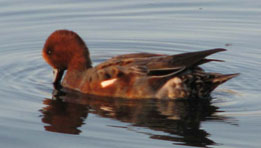
|
Species which have bred in extreme latitudes will be starting to come in to enjoy the relatively mild winter climate of the British Isles. But for many birds, Britain is just a staging post on a long migratory journey, so September is a good time to look out for passage birds resting to feed on their way through. It is the season which makes “twitchers” twitchy, as they anticipate a mouth-watering rarity or two: it is the unexpected which thrills them. After all, this is the season when birds travelling from North America on one side and Siberia on the other take wrong turns, or are wind-blown, and hit the shores of Britain.
But it is the whole dynamism of the change of seasons which really appeals to me. There are so many small miracles to witness. That plump-looking willow warbler feeding avidly in the bushes will be putting on more than a quarter of its own body-weight in energy reserves for the epic journey it faces over the Sahara Desert: weighing just a few grams, it travels annually a greater distance than the average British motorist, and ringing studies have proved that it may live for over ten years. The teal and wigeon arriving at Lavell’s Lake might well have spent the summer above the Arctic Circle evading gyr falcons and Arctic foxes and losing young to snowy owls. Some of the passage waders may have come from Iceland, Greenland, or even Northern Canada and will winter on the shores of Namibia. Arctic terns will be on their way towards the opposite polar region. Last September I encountered a lone young cuckoo in a field in Essex: how did it know that it had to migrate, or where to go? How many of the swallows on that wire will fall prey to an Eleanora’s falcon - a bird which times its breeding to coincide with southward migration - on the Mediterranean coast? That is the joy of birding: the more you look, the more you see. The more you see, the more questions there are to answer. And there is no time like September to get out there and start looking!
Ray Reedman |
Want to find out more? All of these groups do some combination of talks, walks, excursions and conservation work. No previous knowledge is necessary to join any of the activities. Membership fees are modest and guest attendance is usually possible.
Nearby:
Berkshire Ornithological Club: www.berksoc.org.uk (indoor meetings at Palmer Building, Whiteknights; mid-week walks and longer excursions.)
Friends of Lavell’s Lake: www.foll.org.uk (at Dinton Pastures - conservation activities and guided walks)
A bit further afield: (all have indoor meetings, walks and excursions).
Newbury and District Ornithological Club: www.ndoc.org.uk
Royal Society for the Protection of Birds: www.rspb.org.uk. Local groups at: Wokingham/Bracknell; East Berks; Reading
Berks, Bucks and Oxfordshire Wildlife Trusts (BBOWT): www.bbowt.org.uk
Ray will be running a day-school on Autumn Migration for Continuing Education at Reading University, as a field trip to Farlington Marshes on Saturday, 18th October. For details, contact the University: tel 0118 378 8347
|
|
Permeable Paving
Last summer was notable for widespread flooding. Dramatic pictures filled our television screens and locally the Loddon burst its banks; even the brook from Maiden Erlegh Lake overflowed. Torrential rain was partly to blame, of course, but much of the chaos was caused by flash flooding – where for a short period rainfall exceeded the capacity of the drainage system. It was observed that one of the reasons for so much surface storm water was the inability of the ground to absorb the rainfall because so much of it was paved. This is a point, in defence of gardens, that the Royal Horticultural Society has been making for some time. Traditionally gardens have consisted of lawns, shrubberies and flowerbeds, but increasingly they are being taken over by driveways, hard-standings and patios, reducing the amount of available land able to soak up the rain. Here in Earley, just on my way to the railway station each morning – a walk of eleven minutes – I pass at least eighteen drives that have been paved during the past four years. Paving is fashionable: block paving, small-element flag stones, imprinted concrete, not to mention the more utilitarian tamped concrete and asphalt. But is there a conflict between home improvement and the changing natural environment? Not necessarily.
A few months ago BBC’s The One Show conducted an experiment. A victim of last summer’s flooding in Hull was asked to fill up an enclosed area paved with standard concrete paving blocks, while the presenter poured water into a similar pen lined with porous paving blocks. To the apparent amazement of the flood victim, and presumably the anticipated surprise of the viewing public, the porous paving was able to absorb the water as it was poured, while the conventional concrete retained several inches during the conduct of the trial. Faced with this discrepancy in performance, it was obvious that porous paving had something to offer. Indeed, the programme went on to explain that the planning regime was changing to compel householders to move over to porous concrete or other forms of Sustainable Drainage System (SUDS) for all newly-installed driveways from next year.
SUDS can be developed in various ways, using different materials, but the common principles are to capture surface runoff, clean the water, store it and make it available for reuse – all at source. The water infiltrates a permeable surface that reduces pollution levels and allows controlled discharge or storage. In this way SUDS emulates natural drainage patterns within the urban environment, encourages biodiversity and aims to neutralise the adverse drainage effects of intensive development.
Whereas planned drainage is incorporated into the planning process for commercial sites, there is now a momentum to extend such consideration to residential areas. Drainage systems are regulated by official Planning Advice Notes, which are changing to require SUDS in future – in the case of block paving, favouring porous precast over traditional concrete blocks.
Porous blocks look much like any other concrete paving blocks, laid with wide joint spacings filled with coarse grit rather than sand. This layer lies on a permeable laying course or membrane, depending on the system, with the option of a storage box below.
So if you are interested in this ubiquitous impact on the local environment, thinking of home improvement, or prompted by the wet summer weather (and the current flooding in Northern Ireland) you might like to seek more information, technical or general interest (see websites below).
Edwin Trout
|
Royal Horticultural Society: www.rhs.org.uk/NR/rdonlyres/CAAB7116-B48D-4FEB-A68A-B91730EFC07E/0/FrontGardens.pdf
Interpave, the paving and kerbing association has a wide range of downloadable design and maintenance guides, and inspiring case studies: www.britishprecast.org. Appropriate blocks from manufacturers such as Hanson (‘Formpave’ range), Marshalls (‘Prioria’), and Cemex Readypave (‘Uni-Ecoloc’) – details on the British Precast site above – are widely available through builders’ merchants and garden centres.
|
|
GREEN HEROES
Ma Jun born c.1968 Chinese Writer and activist
Ma Jun, 39, became an environmentalist in 1997 after hearing Chinese engineers boast that the Yellow River was a model of water management, even though he knew it was so over-dammed and exploited that it failed to reach the sea on more than 200 days each year. Now he is one of a growing number of people challenging the Chinese culture of official secrecy and saving face. His website names and shames companies and local governments that violate environmental standards, and the former journalist has called to account corporate executives and Communist party cadres with pollution maps. Ma Jun set up the Institute of Public and Environmental Affairs, which co-operates with the central government in a non-confrontational - but highly pragmatic - campaign strategy. Despite the tight controls imposed on independent organisations by the Communist party, there are now 3,000 registered green NGOs, up from fewer than 50 five years ago. Actor Edward Norton writing about Ma Jun in Time magazine stated, ‘It's safe to say that if you put Ma Jun's face on a billboard in Beijing next to basketball star Yao Ming or screen beauty Ziyi Zhang, your average passerby wouldn't have a clue who Ma is. But those who know might argue that China needs heroes like him much more urgently than it does a sports giant or a movie star.’ |
|
THE PAST IS A FOREIGN COUNTRY
A trip down Memory Lane by Alan Broodbank, our Chairman (part 5)
Continuing Alan’s account of exploring Mill and Gypsy Lanes. |
Note my spelling of “Gypsy”, with a “y”. This was how it was then spelt on the road sign, as opposed to the later version when it was changed to “Gipsy”. The name of the road was not inappropriate as gypsies, complete with caravans, did indeed put in an appearance from time to time. Their way of life always fascinated me, and I remember a gypsy boy called John cutting a section of branch about six inches long and about an inch diameter from an alder tree by the river. He then somehow massaged it so that the bark became detached from the pith which could then slide up and down like a piston in a cylinder. When he blew across the top it emitted a clear musical note that sounded like a flute and for which the pitch could be varied by moving the pith up or down. Some folk were wary of the gypsies, but personally I liked them and was disappointed when they moved on.
Sindlesham Mill was still a working flour-mill, a hive of activity that I found fascinating. Everywhere and everything in the immediate vicinity was coated in a layer of white dust, inside and out, accentuating the myriads of cobwebs that festooned everything. Immediately behind the mill the water emerged from a short tunnel in almost a torrent with masses of foam, and opened out into a broad pool. This spot was a favourite with fishermen, with superb specimens of roach, dace, chub and perch in abundance. To get a permit to fish, one simply paid sixpence a day at the mill office (a shilling for adults). Invariably, a newly-arrived angler would soon be joined by Simon, the mill cat, whose primary role in life was apparently to keep the mill free of rats and mice, but who had discovered that there were easier ways of gaining a meal. He would curl up in the grass, purring incredibly loudly, and then go to sleep. Yet he seemed to have a sixth sense that immediately alerted him if the angler was about to land a fish. As the fish was swung in he would give a mighty leap and attempt to grab it in mid-air, frequently successfully. I imagine that as a result he must have swallowed a number of fish-hooks in his time, but he seemed none the worse for it. He was also not averse to wading into the shallow water at the edge in an effort to reach a fisherman’s keep-net, very unusual for a cat.
|
As might be expected, Loddon Lilies (Leucojum aestivum) grew in odd places both upstream and down stream of the mill. For some reason, they seemed to prefer the East bank, a particularly fine clump being adjacent to the small weir about 10 yards upstream of the hump bridge by the mill. It was not at all unusual to find them growing in the water itself, although this was the exception rather than the rule. Sadly, our once-abundant water voles seem to have suffered the same decline as the species has elsewhere and are now but rarely seen. If one walked for any distance along the river, or just sat down quietly, one or two would be sure to be seen, paddling along the margins, in and out of the reed-beds. Just as likely they would be heard rather than seen; they are shy animals, diving at the merest hint of danger, and the walker’s first intimation that a vole was in the vicinity was frequently the unexpected “plop” as it dived into the water.

Kingfishers nested in the bank of the large weir just upstream of the mill; they probably had done for centuries, and hopefully still do. A grandstand view of them diving from an overhanging branch in to catch minnows and then flying back to their nesting burrows could be had by those brave enough to sit on the retaining wall of the weir, with the water thundering through just feet below. I wonder whether the kingfisher population at Maiden Erleigh Lake in fact emanates from the breeding site at Sindlesham? I say this because I saw them fairly frequently in the garden where I used to live in Hillside Road, purposefully flying in one direction or another. The house is roughly equidistant between the two sites, and it seems not impossible that they were in fact migrating for breeding purposes.
The final instalment of Alan’s memories will be in our December newsletter. |
(Continuation of walk from page 1)
A short walk can be taken in Reading, starting at the Town Hall, designed by Alfred Waterhouse. Take a passageway between No. 1 Friar Street and St. Lawrence’s Church. Beyond the churchyard, pass through a brick-pillared gateway, cross the Forbury and enter Forbury Gardens, with its very attractive Victorian flower beds. Take a path straight ahead, and then turn right to pass between the Maiwand Lion, memorial to the Berkshire Regiment killed in an earlier Afghan War (and one of the largest bronze statues in the world), and the bandstand. At the cafeteria, continue on and take a turn round the garden and spot the large cross to the memory of Henry I, founder of Reading Abbey, and also the pretty fountain. Come back to the cafeteria and go through exit to Abbots Walk, where there is a gateway designed by Gilbert Scott, built in 1861 to replace the ancient one which housed the school attended by Jane Austen. At the moment, due to refurbishment there is no exit from the gardens into the Abbey ruins. Continue a short way along Abbots Walk until you come to a passage on left. Go past St. James Catholic church on your right
till you come to the dual carriageway. Walk to roundabout with prison on your right. Some of the old parts of the prison which would have been known to Oscar Wilde are still visible. Follow perimeter of prison round until you come to Chestnut Walk, then turn right into the Walk and you will see the memorial gates and railings to Oscar Wilde. At the end of Chestnut Walk turn right into Abbey Ruins (partly closed). Retrace steps to Chestnut Walk, and then either cross bridge to main road or go through small gates to office buildings, take steps in corner on right. Pass a small garden on right and arrive back at Abbots Walk and Forbury Gardens.
(Walk had to be adjusted because of renovations to Abbey Ruins).
(Reference Walks with Writers, Elizabeth Cader-Cuff; Reading Gaol by Reading Town, Peter Southerton, which contains The ballard of Reading Goal. |
|
| Two Important events in the EEG Calendar |
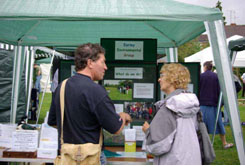 We had a stand at the Earley Green Fair which, in spite of unkind weather, was very popular with local people. Our stand attracted many visitors, and we gained new members. The winner of our bird quiz was Rohan Inston. We also signed up local children for our Bug Hunt on August 6. Alan Broodbank, our chairman, who is passionately interested in wildlife and an expert in entomology, put in lots of pre-planning to make this a memorable event for the youngsters. We had a stand at the Earley Green Fair which, in spite of unkind weather, was very popular with local people. Our stand attracted many visitors, and we gained new members. The winner of our bird quiz was Rohan Inston. We also signed up local children for our Bug Hunt on August 6. Alan Broodbank, our chairman, who is passionately interested in wildlife and an expert in entomology, put in lots of pre-planning to make this a memorable event for the youngsters. 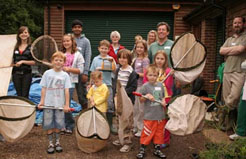 They looked like intrepid Victorian explorers, with their sweep nets and bug boxes, entering normally out-of-bounds overgrown wild places in Maiden Erlegh Reserve. Lots of little creatures were bewildered by large eyes peering at their every detail, but were all eventually returned to their rightful habitats. The children and their parents were astonished and delighted by the moths that Alan had trapped in his light-box the previous night, which were released to float happily upwards to freedom. Alan opened the eyes of these youngsters to the wonders of the natural world. (Take time to see the enthusiasm children can display for the natural world in the album of photographs on www.earleyenvironmentalgroup.co.uk, ‘Bug Hunt’) They looked like intrepid Victorian explorers, with their sweep nets and bug boxes, entering normally out-of-bounds overgrown wild places in Maiden Erlegh Reserve. Lots of little creatures were bewildered by large eyes peering at their every detail, but were all eventually returned to their rightful habitats. The children and their parents were astonished and delighted by the moths that Alan had trapped in his light-box the previous night, which were released to float happily upwards to freedom. Alan opened the eyes of these youngsters to the wonders of the natural world. (Take time to see the enthusiasm children can display for the natural world in the album of photographs on www.earleyenvironmentalgroup.co.uk, ‘Bug Hunt’)
|
BUTTERFLY GARDEN MAKE-OVER
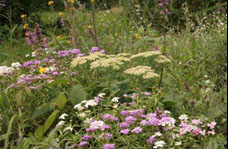 EEG members, who are part of the Wednesday group working in Maiden Erlegh Reserve with Grahame, helped to give the butterfly garden near Instow Road a make-over. It was tidied up and planted with flowers greatly valued by butterflies (and bees). Plants, like nettles, were included for their attraction as food sources for caterpillars. (To volunteer help, phone Grahame on 07796170689) EEG members, who are part of the Wednesday group working in Maiden Erlegh Reserve with Grahame, helped to give the butterfly garden near Instow Road a make-over. It was tidied up and planted with flowers greatly valued by butterflies (and bees). Plants, like nettles, were included for their attraction as food sources for caterpillars. (To volunteer help, phone Grahame on 07796170689)
|
|
VETERAN TREES’ VITAL STATISTICS
You may like to read some of the statistics yielded by the veteran tree survey at present being carried out in Earley as part of a district-wide survey, and provided by Elaine Butler. Earley has many impressive trees and hedge remnants from its rural past which enhance our built environment. The details below are by no means a complete picture as there are still more trees to be recorded. ET = Earley Town and WBC = Wokingham Borough Council (meaning the whole district). So far -
There are 120 veteran trees recorded for ET (approx. 9% of WBC total of 1356)
Largest oaks in WBC: 8.92m and 8.20m girth*, largest in Earley 5.10m girth**
Most frequently-recorded trees, WBC: English oak, willow, ash. ET: English oak, hawthorn, ash, willow
The oak beats all the other species by a large margin, 896 across the district, 80 for Earley.
Willow is the second most frequent. In Earley willows recorded were white, goat and crack.
* in Shinfield Park ** To date. Larger ones not yet entered on the survey.
|
|

|
Lest we forget...
Not many people alive now will remember the moment the First World War came to an end, but this gives a flavour of that moment, written by someone who was 12 at the time and taken from a personal family history. ‘The war lasted for four years and I remember going to school one morning and the teacher said, "Now I want you to listen at 11 o'clock for the sound of the maroons which will mean the war is over" - which was the 11th hour of the 11th day, of the 11th month - which we did and we all cheered and were allowed to go home for the rest of the day. It was a great day, especially in London, everybody dancing in the streets, on the tops of buses and trams which had open tops in those days.’
This celebration was bought at a heavy cost. Whatever one’s personal opinion about war, much anguish must have been experienced by families on all sides who were drawn into this conflict. There was hardly a family in the whole of the country which didn’t suffer the loss of someone dear to them. The Reading Standard published a very large book after the war which contained hundreds of photos of Berkshire men who had served, some of whom had been wounded, taken prisoner or died. This contained several photographs of Earley personnel.
What heartbreak the parents of Lieutenant Brian John Dunlop must have felt on hearing the news of his death. His memorial on the Commonwealth War Graves Commission website states he was of the 3rd Coy. 3rd Bn., Grenadier Guards who died age 19, on 31 July 1917. Son of Mrs. and the late H. W. Dunlop, of Maisonnette, Earley, Reading, he is remembered with honour, Bleuet Farm Cemetery, Belgium. At 19 his life had hardly begun. He is one of 437 UK personnel buried there. Three soldiers buried there were shot at dawn for desertion, evidence of the toll war extracts on individuals. One wonders how Harry Street, ‘late of Earley’ came to serve as an Able Seaman in the Royal Australian Navy Reserve, and died 11 September 1914 in a raid on a German colony in German New Guinea, trying to take a radio station. He took part in a particularly bloody battle at Bita Paka. His grave is a long way from Earley and he is remembered in Rabaul (Bita Paka) war cemetery in Papua New Guinea. Five naval personnel who died in the operation at Rabaul are buried there. A sandstone memorial, located within the cemetery adjacent to the WW I graves, bears testimony to this event.
Five sons of Mr. & Mrs. G. J Fisher of Radstock Farm all served, two in the Royal Berks Regiment and the other three as stokers in the Royal Navy. None was recorded as having died but Lce. Corporal C. J. Fisher of the 2nd batt. Royal Berks was wounded and taken prisoner. With so many men away at war, the land still had to be tended. With men away at war a big recruitment drive was held in Reading to get women to join the Women’s Land Army. It was said at the event, ‘the need was urgent, the times were pressing, the harvest must be got in, the threshing must be done, and the cows milked.’
Private A E Bolton, of Bulmershe Cottage, aged 26, no. 23760, 1st Bn., Northamptonshire Regiment, died on 16 August 1916. He is remembered at Bazentin-Le-Petit Communal Cemetery Extension. This is a wartime cemetery, started after the capture of the village and used until December 1916, when it would have contained around 135 burials. Private Albert Saunders of Station Cottages was wounded. Rifleman W.A. Parsons of 2 Belle Avenue was a prisoner-of-war in Germany. 2nd Lt. F. J. Cunningham of the Royal Flying Corps, of ‘Westdene’, Earley died at home of illness contracted on active service. Pte. A. T. Brooks, Upperwood Cottage, Lower Earley, was awarded the Meritorius Service Medal. Leonard Goodhart Sutton, of Sutton Seeds, tragically lost four of his five sons, their ages between 19 and 22, one buried as far away as Israel.
Earley took steps to support serving personnel. Two rifle ranges were erected in Earley. Sports were held in Church Field (Sol Joel Park) in October 1915 for the Earley Company of the lst Batt. Volunteer Regt, and a photo of this event exists, showing Sol Joel in the centre. Col. Frank Weldon of Erlimount, Earley threw open his garden and each day a different group of service people were entertained, for instance Wednesday was the day for the Canadian troops from Bearwood, and Friday for wounded soldiers. There was cricket, football, bowls, quoits, German skittles, a rifle range, rounders and baseball. Major E.S. Weldon, son of Col. Weldon, of the Dorset Regt. was wounded and mentioned in despatches.
(Remembrance Sunday is November 9th) |
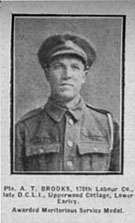
Pte. Brooks awarded the Meritorius
Service Medal |
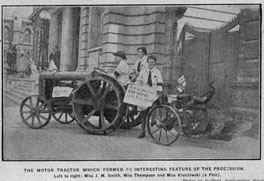
Recruiting for the Women’s Land Army |
|
NEWS FROM BEYOND EARLEY
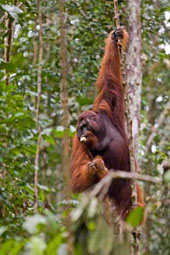 What price an orang-utan? It makes the heart sink to read the plight of this most appealing of animals, whose numbers have halved in the last twenty years. Recently EEG raised enough to buy an acre of rainforest for the World Land Trust. WLT have started an appeal to buy thousands of acres of the tropical forest in Borneo. They are currently trying to achieve £343,364 by Christmas, a cost of £568.48 to save each of the 604 orang-utans known to be living in the neighbouring reserves. If you feel like contributing, the website is www.justgiving.com/worldlandtrustborneo, or write to World Land Trust, Blyth House, Bridge Street, Halesworth, Suffolk, IP19 8AB. What price an orang-utan? It makes the heart sink to read the plight of this most appealing of animals, whose numbers have halved in the last twenty years. Recently EEG raised enough to buy an acre of rainforest for the World Land Trust. WLT have started an appeal to buy thousands of acres of the tropical forest in Borneo. They are currently trying to achieve £343,364 by Christmas, a cost of £568.48 to save each of the 604 orang-utans known to be living in the neighbouring reserves. If you feel like contributing, the website is www.justgiving.com/worldlandtrustborneo, or write to World Land Trust, Blyth House, Bridge Street, Halesworth, Suffolk, IP19 8AB.
The photo is by kind permission of Chris Grady who wrote in reply to my request to use the picture: “No problem at all. Anything that makes people aware of the plight of the rain forest and its wonderful inhabitants in Borneo will get my support. As you will know from the dates of my Borneo images, I was in Borneo for three weeks earlier this year and was totally shocked by the lack of rain forest left. On one day-long bus ride across the island I estimated 85-90% of the countryside we passed was plantations. You read it and see about it on TV, but I was truly shocked by the lack of rain forest.” See Chris’s website of lovely wildlife photos on www.wildlife-imaging.co.uk.
Are our young people losing touch with the natural world? Sir David Attenborough is dismayed by the findings of a recent poll of 700 children by the BBC Wildlife Magazine. This found half of the 9-11- year- olds could not identify common subjects like bluebell, an oak tree, etc. and only 12% could identify a primrose! ‘The wild world is becoming so remote to children that they miss out,’ Sir David said, ‘and an interest in the natural world doesn't grow as it should. Nobody is going protect the natural world unless they understand it.’ Fergus Collins, of BBC Wildlife Magazine, said the results ‘reinforce the idea that many children don't spend enough time playing in the green outdoors and enjoying wildlife – something older generations might have taken for granted’. Perhaps we should take some wisdom from the magazine article, ‘Experts blamed the widening gulf between children and nature on over-protective parents and the hostility to children among some conservationists, who fear that they will damage the environment. They said that this lack of exposure to outdoor play in natural environments was vital for children's social and emotional development. Most disturbing is the finding that playing in the countryside was children's least popular way of spending their spare time, and that they would rather see friends or play on their computer than go for a walk or play outdoors.’ Sad, eh?
|
NEWS FROM EARLEY AND WILDLIFE SIGHTINGS
Margaret and Gillian, two regular contributors of garden wildlife surveys: Our two regulars have filed their monthly surveys. Garden A in built-up area has some limited tree cover nearby, garden B is very near High Wood, so has advantage of being next to woodland. How did your garden fare in comparison for the month of July?
BIRDS:
In both gardens: blackbird, blue tit, chaffinch, goldfinch, great tit, magpie, red kite (sighted overhead).
Only in garden A: collared dove, green woodpecker, gr. spotted woodpecker (neighbour’s oak tree),
Only in garden B: greenfinch, songthrush, wren, whitethroat*, long-tailed tit
Notable absences: house sparrow, starling. Collared dove in only one garden.
The highest number of birds seen at one time: Garden A blue tit 3 (taking baths); Garden B blue tit 14 (on peanuts, drinking and bathing), long-tailed tit 12 (in plum tree), greenfinch 7 (in plum tree after greenfly), wren 7 (nesting).
Some interesting observations: the goldfinch were attracted by niger seed, robin caught in fruit net but released, blackbird after green grapes, one song thrush which looked poorly was later found dead.
 *Common and lesser whitethroat, a summer visitor. An old popular name was ‘Nettlecreeper’. Hear the song on *Common and lesser whitethroat, a summer visitor. An old popular name was ‘Nettlecreeper’. Hear the song on
http://www.garden-birds.co.uk/birds/whitethroat.htm.
(Common whitethroat)
BUTTERFLIES:
In both gardens: holly blue, small white
Only in garden A: red admiral, speckled wood, gatekeeper
Only in garden B: painted lady, peacock
ALSO SEEN:
Garden B: Common hawker dragonfly. Widespread and locally common. Flies from mid-June to October, and is most often seen hawking over breeding areas and along the edges of woodland; Hornet. This is our largest social wasp. Queens are huge and cannot be confused with other wasps. Despite its appearance, it seldom stings humans.
Garden A: Grasshopper. This uses its legs to catapult itself twenty times the length of its body. If we did that we would
be in the 2012 Olympics reaching nearly 40 yards!
|
|
LOCAL FORTHCOMING EVENTS
September:Join our HEDGEHOG HOME-building session on Saturday, September 13 from 2 to 4 p.m. at the Maiden Erlegh Reserve Interpretation Centre, Instow Road. No expertise needed. Everyone, including children, welcome. Donation to cover cost of materials. To find the Interpretation Centre: take Chelwood Road off Beech Lane, then first left into Instow Road. Follow this round to the farthest corner next to the Maiden Erlegh Nature Reserve.
October: “AUTUMN: A TIME OF MOVEMENT”, a talk by Ray Reedman, Thursday 16 October at the Parish Room, Radstock Lane Community Centre, Earley RG6 3UZ, 7.15 for 7.30 p.m. to approx. 9.15 p.m. Make sense of the birds you see locally and in your garden with Ray, a very knowledgeable local ornithologist, who will give us a fascinating insight into the comings and goings of our birds at a time of year when many are on the move. Venue is next to Radstock Primary School. Free admission but voluntary contribution appreciated to cover expenses. Refreshments. Everyone welcome.
November 18: WANT TO FIND OUT MORE ABOUT WASTE AND RECYCLING? Peter Baveystock, Waste and Recycling Manager, Wokingham Borough Council will give a talk and will be happy to answer all those queries you have. Tuesday November 18, 7.30 to approx. 9.15, Function Room, Maiden Place Community Centre, Earley. To find the Function Room, take Kilnsea Drive, off Rushey Way, Laurel Park end, then second turning on right. Follow bend to right until you reach second car park for the Centre, which is on left.
December 15 (Monday) EEG Christmas social. Details to follow.
BITS AND PIECES
Wokingham District Veteran Tree Assn. A talk by Ted Green, of the Ancient Tree Forum, on Veteran Tree Archaeology, Wednesday November 19th at St Mary's Church Centre, Station Road, Twyford RG10 9NT 7.30 - 9.30 p.m. (doors open 7.10 p.m.) Admission £3 to include refreshments. You will be sure of a very entertaining and knowledgeable talk.
Reading’s Climate Change Event of the Year: Hosted by GREN (Greater Reading Environmental Network) and COIN (Climate Outreach and Information Network) Sunday Sept. 28, 1.30 to 4.30 p.m. Book a free place at Friends Meeting House, 2 Church Street Reading RG1 2SB to find out about forming a Climate Action Group to reduce Greater Reading’s carbon footprint. Phone 01865 403334 or e-mail catrina@coinet.org.uk. http://groups.yahoo.com/group/ReadingEnvNetwork
RSPB Birds Magazines from summer 1997 to end of 2007 offered to anyone who cares to ring Erica on 0118 987 3476.
EEG Committee Members can be found on www.earleyenvironmentalgroup.co.uk under Contacts, or phone 0118 962 0004.
For Wildlife Survey Forms, go to the website or phone Earley Town Council 0118 986 8995
Comments or contributions to the newsletter to: sheila.crowson@ntlworld.com or 2 Reeds Avenue, Earley, RG6 5SR. We would welcome short contributions from members to the newsletter.
If you know anyone who would like to join EEG, membership forms are available from Earley Town Council, 0118 986 8995, on the website under Downloads, or send an e-mail to Liz Wild liz@helva.plus.com. Please inform Liz if you intend to change e-mail or address at 50 Kenton Rd, Earley RG6 7LG, or send her an e-mail.
Can you offer active help to the Group? Phone 0118 962 0004 if you can. If you have no expertise and would like to get involved, you may be able to give practical help. We also need people with some expertise to undertake surveys of small habitats in Earley. To join the Earley Veteran Tree Survey phone 0118 962 0004.
|
SUPPORT YOUR LOCAL SHOPS
The True Food Co-op, Silverdale Centre
There is now a True Food Co-op operating in Earley. Their mission is to take low cost organic food out to the people, bypassing the supermarkets which charge a lot for organics They hold markets at the Silverdale Centre now every Friday, 5pm to
8. 15pm. They have a website giving details www.truefood.coop/truefood.html
Pet Fayre 9 Maiden Lane Centre Lower Earley
A small independent shop, with bird feeders of all kinds, a variety of bird feed, large bags of which the shop is willing to deliver locally, or pick it up in your car from the back of the shop Tel 0118 9266512, or email janet@petfayre-reading.co.uk.
No Page Unturned: A new bookshop in Earley, 3 Maiden Lane Centre. Emily will get any book you need in 24/48 hrs, 5% off for EEG members.
Phone her on 0118 966 9351 or e-mail emily@nopageunturned.org.uk. Visit her pleasant premises and browse. New and second-hand books, wrapping paper, audio books, etc. |
|
Thanks to ORACLE for reproducing our newsletter on recycled paper. Oracle is the world's second-largest software company, situated at Thames Valley Business Park in Earley. Oracle UK is environmentally accredited to the ISO 14001 standard, which confirms Oracle has considered and acted against its environmental impact. As part of their corporate social responsibility, they support a number of local groups, including us. They have given us valuable support in reproducing the hard copies of our newsletter in colour to distribute to members, libraries, schools etc., as well as printing off posters and membership leaflets. |
|